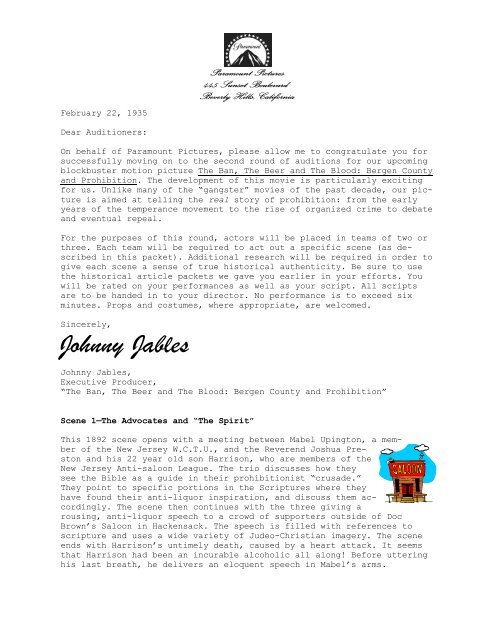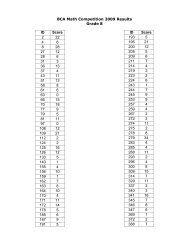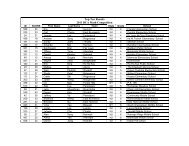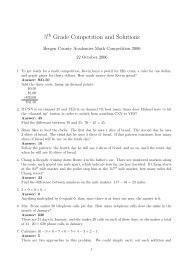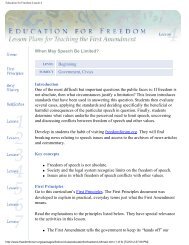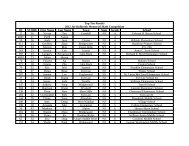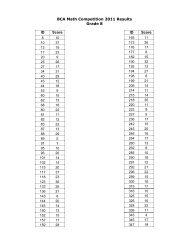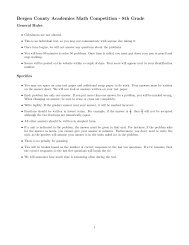Prohibition Role Play Activity - Bergen County Technical
Prohibition Role Play Activity - Bergen County Technical
Prohibition Role Play Activity - Bergen County Technical
Create successful ePaper yourself
Turn your PDF publications into a flip-book with our unique Google optimized e-Paper software.
February 22, 1935<br />
Dear Auditioners:<br />
On behalf of Paramount Pictures, please allow me to congratulate you for<br />
successfully moving on to the second round of auditions for our upcoming<br />
blockbuster motion picture The Ban, The Beer and The Blood: <strong>Bergen</strong> <strong>County</strong><br />
and <strong>Prohibition</strong>. The development of this movie is particularly exciting<br />
for us. Unlike many of the “gangster” movies of the past decade, our picture<br />
is aimed at telling the real story of prohibition: from the early<br />
years of the temperance movement to the rise of organized crime to debate<br />
and eventual repeal.<br />
For the purposes of this round, actors will be placed in teams of two or<br />
three. Each team will be required to act out a specific scene (as described<br />
in this packet). Additional research will be required in order to<br />
give each scene a sense of true historical authenticity. Be sure to use<br />
the historical article packets we gave you earlier in your efforts. You<br />
will be rated on your performances as well as your script. All scripts<br />
are to be handed in to your director. No performance is to exceed six<br />
minutes. Props and costumes, where appropriate, are welcomed.<br />
Sincerely,<br />
Johnny Jables,<br />
Executive Producer,<br />
“The Ban, The Beer and The Blood: <strong>Bergen</strong> <strong>County</strong> and <strong>Prohibition</strong>”<br />
Scene 1—The Advocates and “The Spirit”<br />
This 1892 scene opens with a meeting between Mabel Upington, a member<br />
of the New Jersey W.C.T.U., and the Reverend Joshua Preston<br />
and his 22 year old son Harrison, who are members of the<br />
New Jersey Anti-saloon League. The trio discusses how they<br />
see the Bible as a guide in their prohibitionist “crusade.”<br />
They point to specific portions in the Scriptures where they<br />
have found their anti-liquor inspiration, and discuss them accordingly.<br />
The scene then continues with the three giving a<br />
rousing, anti-liquor speech to a crowd of supporters outside of Doc<br />
Brown’s Saloon in Hackensack. The speech is filled with references to<br />
scripture and uses a wide variety of Judeo-Christian imagery. The scene<br />
ends with Harrison’s untimely death, caused by a heart attack. It seems<br />
that Harrison had been an incurable alcoholic all along! Before uttering<br />
his last breath, he delivers an eloquent speech in Mabel’s arms.
Scene 2—The Disbelieving Editors<br />
This scene begins at the offices of Harper’s Weekly Magazine<br />
in January of 1909. Henry Chambers, a middle-aged man and<br />
self-proclaimed recovering alcoholic, is pitching his<br />
manuscript, titled “A Story of an Alcohol Slave.” Chambers<br />
describes his manuscript in detail, and talks about some<br />
of his most harrowing experiences as an alcoholic. After<br />
listening to his pitch the two editors, James Mallow and Arthur Newby,<br />
openly question the story’s authenticity. Mallow is particularly disturbed<br />
at Chambers’ negative portrayal of saloonkeepers, whom he regards<br />
as legitimate businessmen. An angry debate follows between the two sides,<br />
as each side uses the manuscript to make their points. The scene ends<br />
with Chambers storming out of the meeting in tears.<br />
Scene 3—Ratification Debate in the New Jersey Legislature<br />
Here we are witness to a passionate debate, on the eve<br />
of the ratification of the 18th Amendment, between two<br />
members outside the main chamber of the New Jersey State<br />
Assembly. An argument is underway between Assemblyman<br />
(and Reverend) Clyde Hallow, an avowed prohibitionist<br />
who believes that beer is the “Devil’s Brew,” and Assemblyman<br />
Arthur Fenmore. Fenmore is also Vice President of<br />
the Beerbrewers Guild. Both are using all of the statistics,<br />
stories and sources they can muster in trying to convince the feckless,<br />
confused Assemblyman James Barrow of Hackensack to vote for their<br />
side. In the end, Barrow does decide to vote one way or the other...and<br />
we’ll leave it up to the auditioning actors to decide. Just be sure to<br />
have Barrow explain the reasons for his vote.<br />
Scene 4 — A Meeting Between Three “South Hackensack” Toughs<br />
This scene is set on a sweltering July night in the summer of<br />
1920, in the back office of Otello’s Pool Hall in South Hackensack,<br />
N.J. Sitting around the table are three local troublemakers.<br />
“Fat Tony” Otello, who owns the place, has recently<br />
been released from prison after serving a three year sentence<br />
for bribery. James “Sweetface” Donohue is on the run from the<br />
<strong>Bergen</strong> <strong>County</strong> Police for robbery. Jason “The Drill” Farrow is<br />
wanted in three states for jailbreaks. James proposes turning<br />
the pool hall into a speakeasy, but he needs the help, muscle and money<br />
of the others. When Fat Tony and Jason doubt its profitability, James describes<br />
how the “Iron Law of <strong>Prohibition</strong>” will turn their speakeasy into<br />
a cash cow. The scene ends with James collecting $2000 each from the men,<br />
and then dashing out the front door to a waiting car through a hail of<br />
gunfire...never to be seen again!
Scene 5 - The Death of Sally Scrambleseed<br />
This scene is set in the Emergency Room of Hackensack Medical Center.<br />
On a cold November evening in 1927, a comatose Sally Scrambleseed is<br />
brought in by her panicking friend Velma Kelly after a “night<br />
on the town.” Sally is immediately examined by Dr. Charlie<br />
Greenfield, who determines after a blood test that Sally is<br />
a victim of alcohol poisoning. Sally soon dies, leaving<br />
Velma wondering how a seemingly healthy young person could die<br />
from a single glass of whiskey. Dr. Greenfield then explains the role of<br />
product concentration with prohibited substances, and how it all relates<br />
to Sally’s death. The scene ends when Greenfield, who has fallen in love<br />
with Velma, proposes marriage.<br />
Scene 6 - The Parole Hearing of Baby Face Moretti<br />
This scene, set at Rahway State Penitentiary in May of<br />
1946, places the infamous Hackensack Gangster William<br />
“Baby Face” Moretti before the visiting New Jersey<br />
State Parole Board.<br />
Scene 6 - The Governor at Princeton<br />
This scene is set in the office of Princeton University president<br />
John Grier Hibben in June of 1932. The pro-temperance<br />
governor has paid him a visit to complain about a recent article<br />
Hibben has published in major New York area magazines<br />
which expresses his strong opposition to <strong>Prohibition</strong>. Hibben,<br />
a former “dry” has apparently turned “wet,” and the governor<br />
wants to know why. A debate ensures between the two on the<br />
merits and detriments of repeal. The scene ends with the governor breaking<br />
down in tears, and bolting from Hibben’s office.


